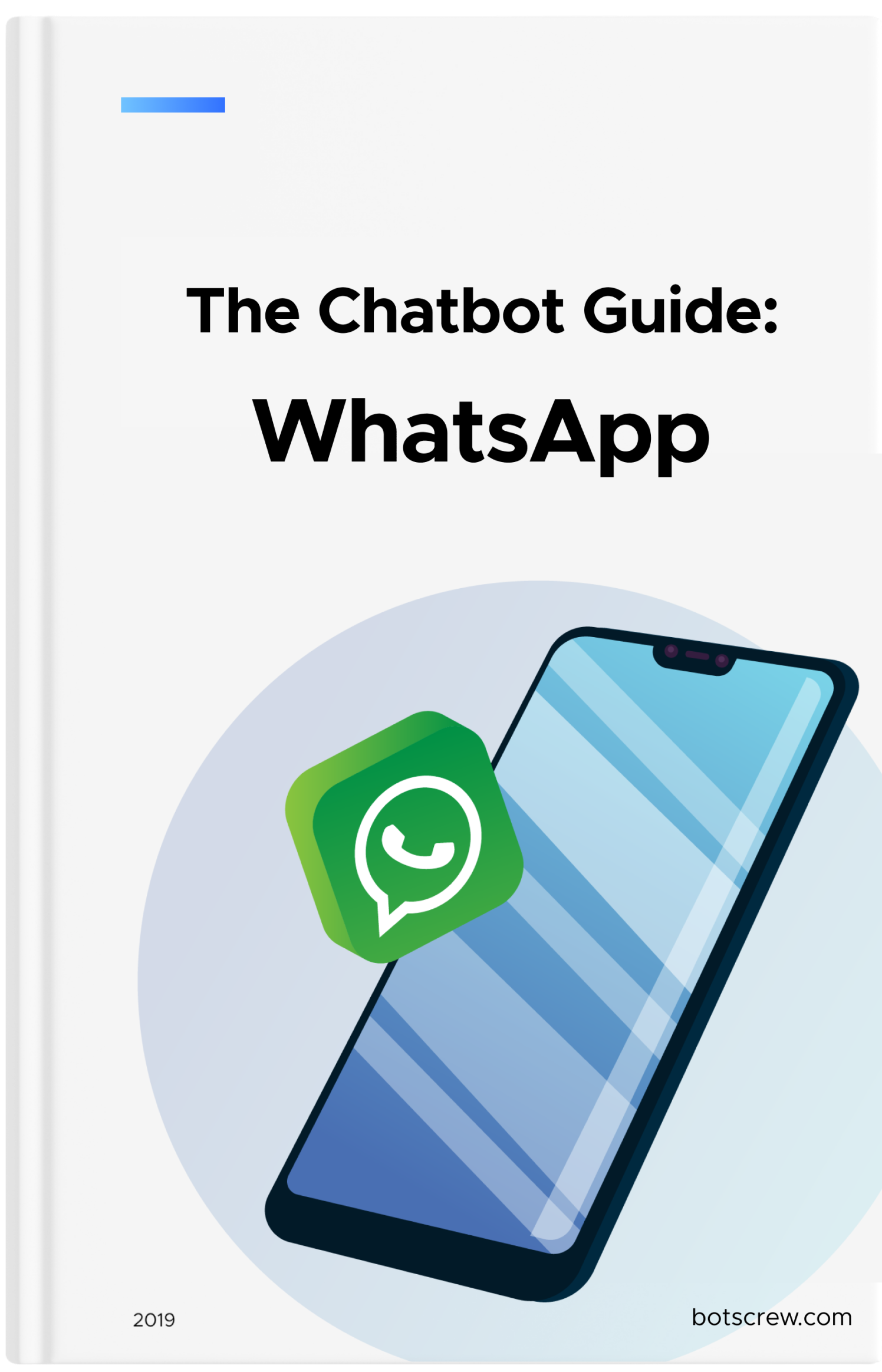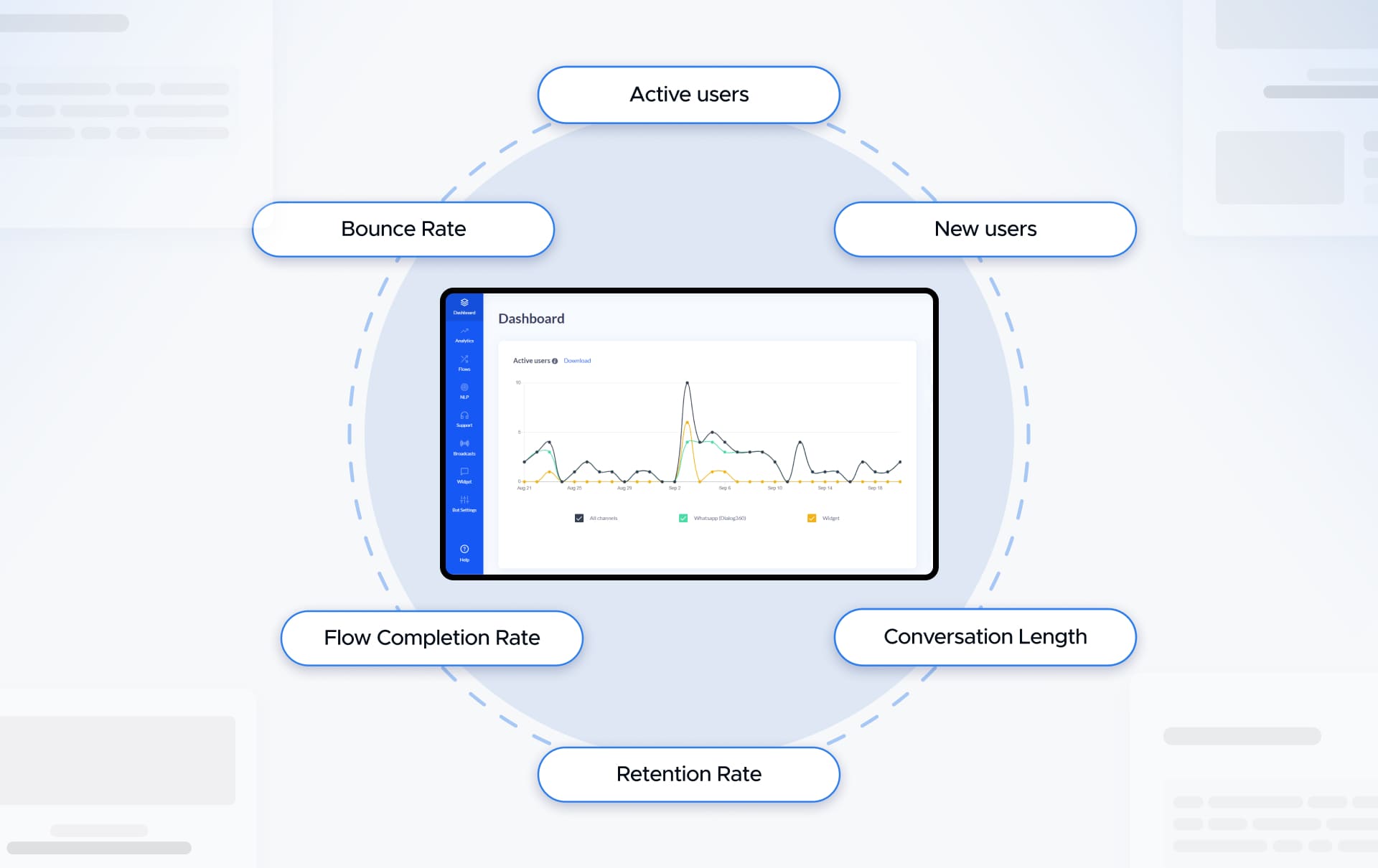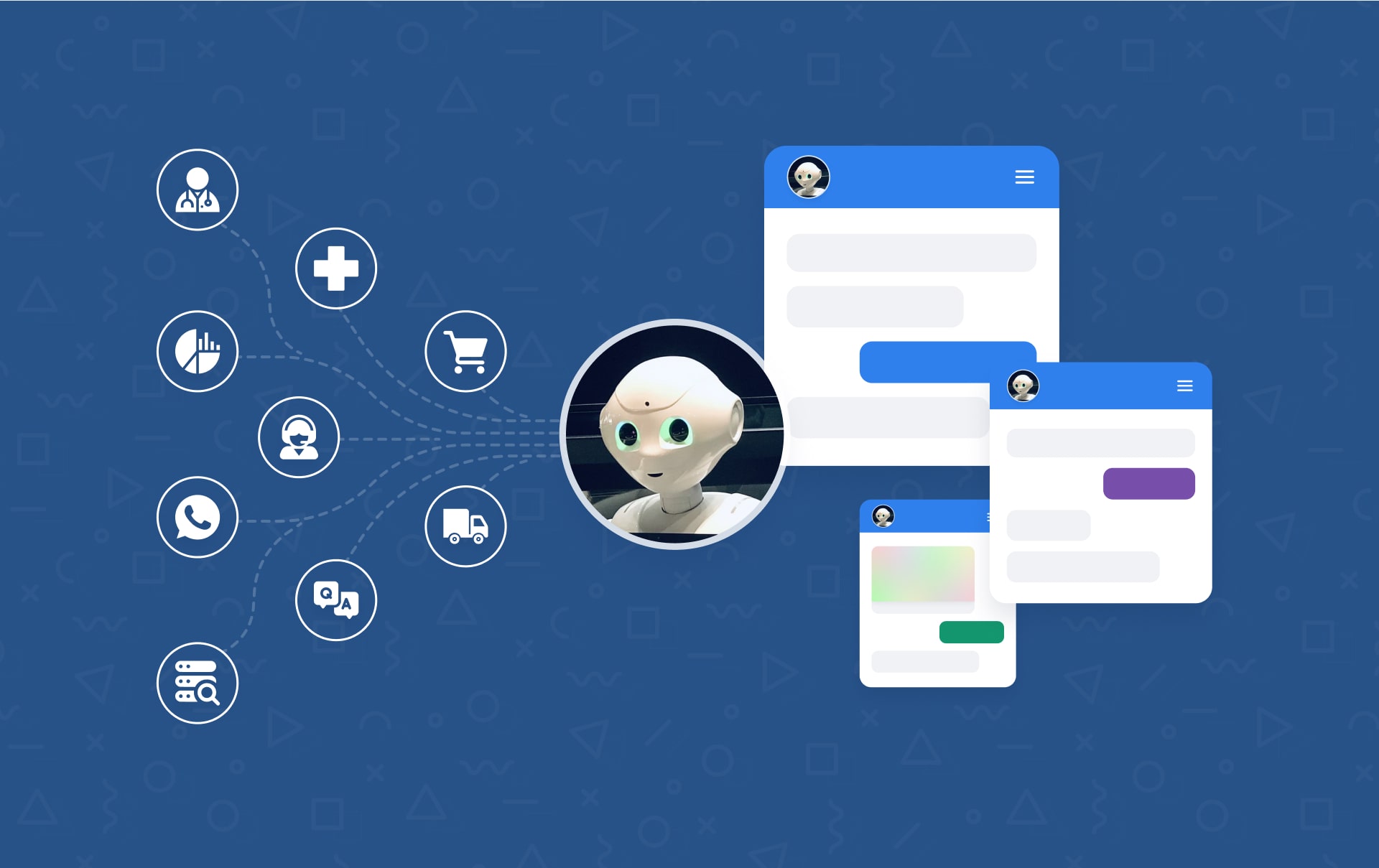53% of Enterprises Embrace RPA Chatbots for Business Automation
Nowadays, Robotic Process Automation (RPA) bots and Conversational AI are two winning AI technologies. We've highlighted how to maximize your business growth using RPA chatbots.
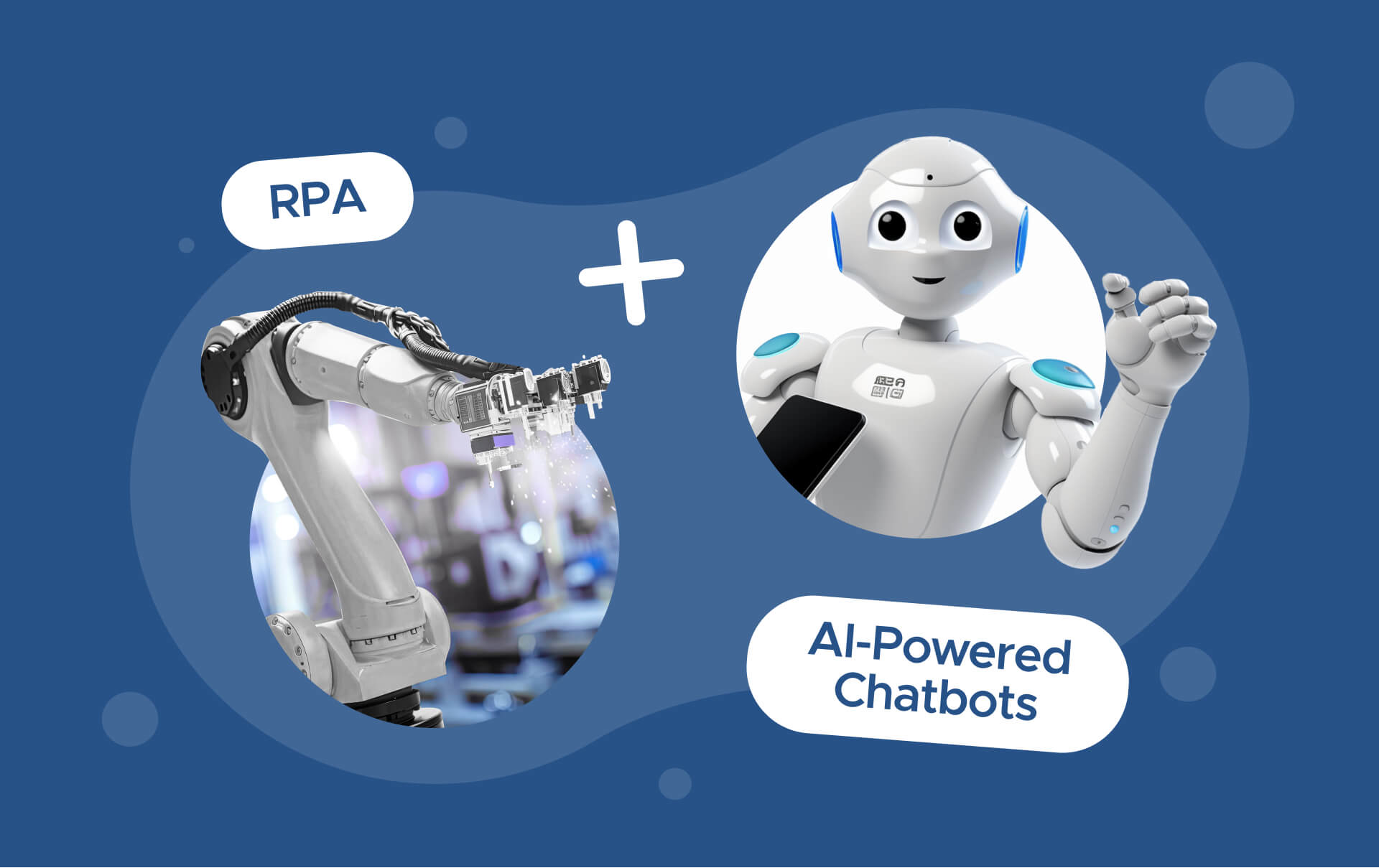
Most people at least once had a strong feeling that they were performing a task that actually should be automated. A survey by Entrepreneur found that 40% of full-time employees end up wasting an hour or more a day on administrative jobs that don't drive value for their company.
This way, specialists waste the resources of their working memory, and time to perform more strategic and important business tasks. In addition, performing mind-numbing tasks daily reduces the overall level of motivation.
Imagine automating humdrum, high-volume tasks with RPA chatbots, leaving your employees free to resolve more complex jobs! What role does AI play in this process? Which AI capabilities help drive the business value of robotic process automation (RPA)?
In this blog post, we'll delve into the main differences between RPA and GPT-powered chatbots, the key benefits of RPA, as well as chatbot integration with RPA examples and use cases that are helping enterprises make the most of these two technologies.
What Is Robotic Process Automation (RPA)
Robotic process automation (RPA) is a technology used to build, deploy, and manage software robots that emulate human actions interacting with various digital systems and software. It can understand what is on a screen, navigate systems, identify and extract data, fill out forms, copy/paste information, and more.
Robotic Process Automation refers to the following parts:
- Robotic: IT systems, such as Machine Learning (ML), Artificial Intelligence (AI), and GPT-powered chatbots are designed to simulate human actions, processes, and tasks.
- Process: Businesses run on processes. With RPA, the company's specialists shift to higher-value and more value-added tasks, away from simple and repetitive processes.
- Automation: Administrative business tasks can be automated with the right systems in place. Using RPA for small businesses and large enterprises can simplify and streamline the work that staff are doing.
RPA software is your silent partner in crime. It works invisibly in the background, performing tasks that help your business run smoothly, although your customers or website visitors may not even know it is there.
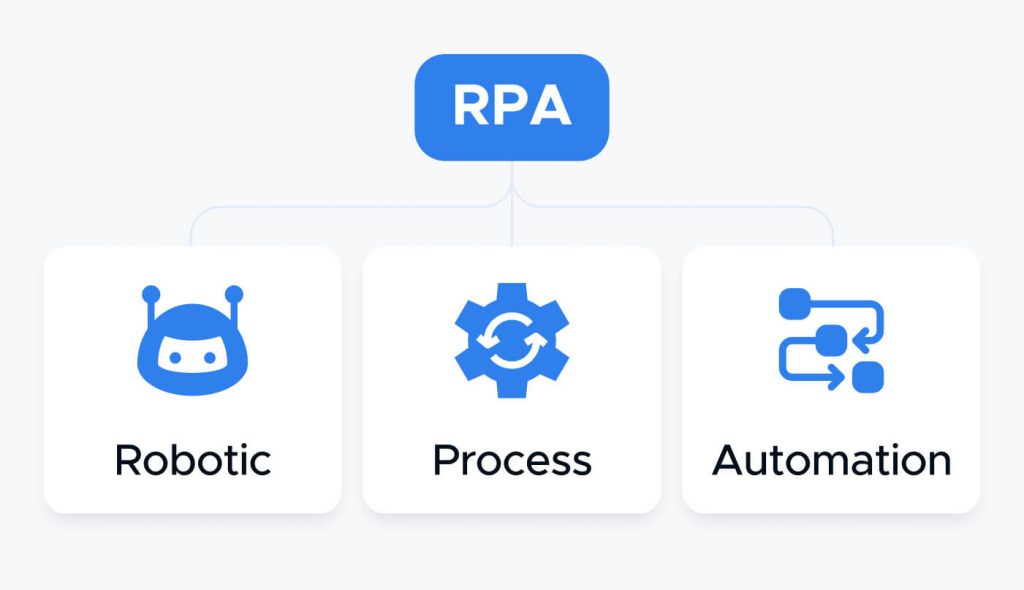
Robotic process automation (RPA)
RPA has been adopted by large enterprises, as well as medium-sized, and small businesses to automate and make their tasks more smooth and productive. The law industry is one of the areas where chatbot & RPA chatbot development has become the most important business tool.
We at BotsCrew have been engaged in chatbot development, including for law firms, and we see that the bulk of this growth has occurred in recent years. In 2016, we launched Ailira, an AI Legal Information Research Assistant that is now helping our customer, an Australian law company specializing in tax law and commercial law related to tax and businesses, with business structuring, document generation, and other legal issues.
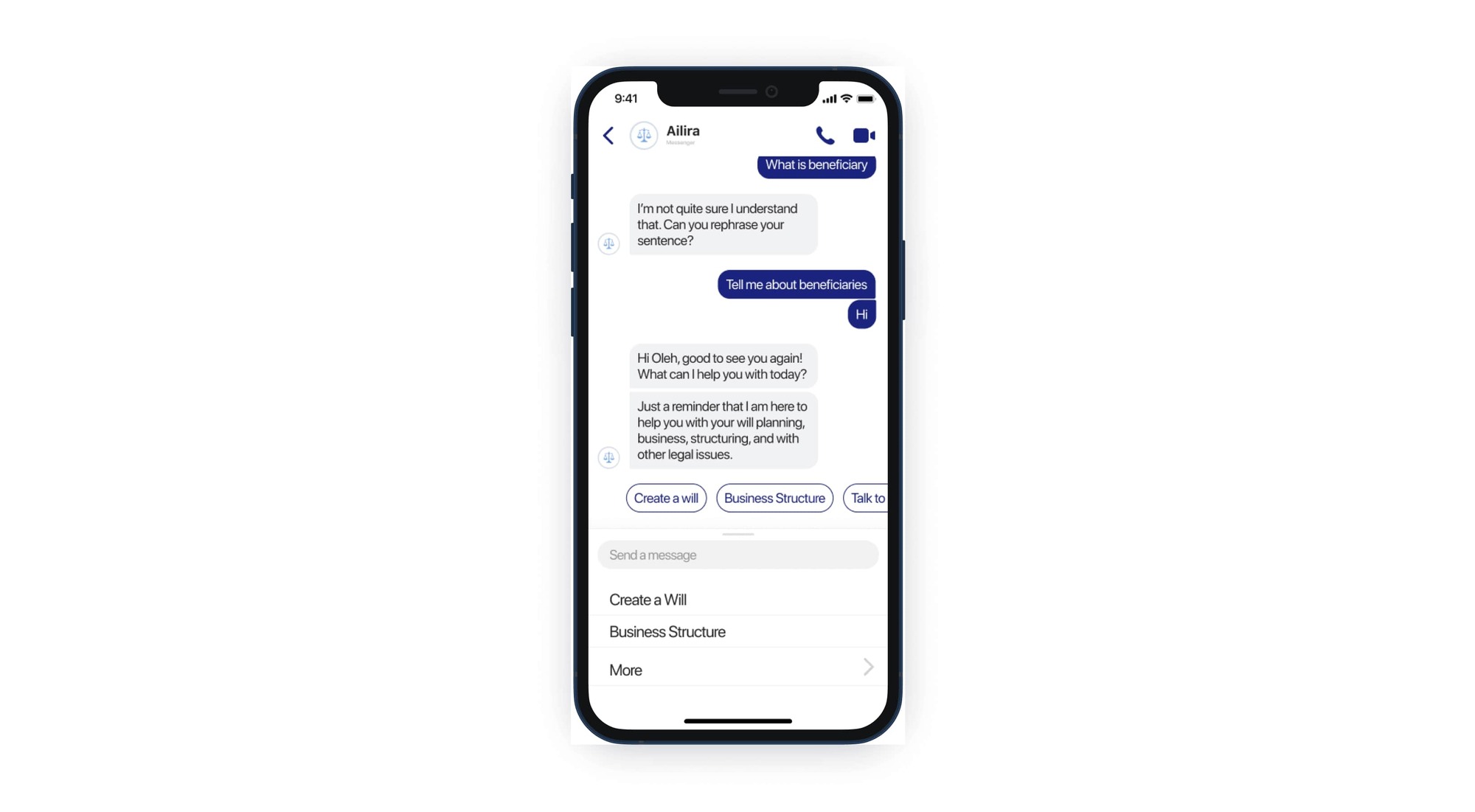
Ailira Chatbot
Too much of our customer's time was spent on non-billable administrative tasks. According to research, in all, administrative tasks account for 48% of the average lawyer's day. The expense of long working hours, poor productivity level, and less time for clients created by mundane tasks give rise to the need for next-gen technology such as robotic process automation (RPA).
We've developed a Facebook Messenger and Website chatbot that can answer different law questions, create templated contract drafts, and compile legal citations. It includes great NLP abilities and a user-friendly design.
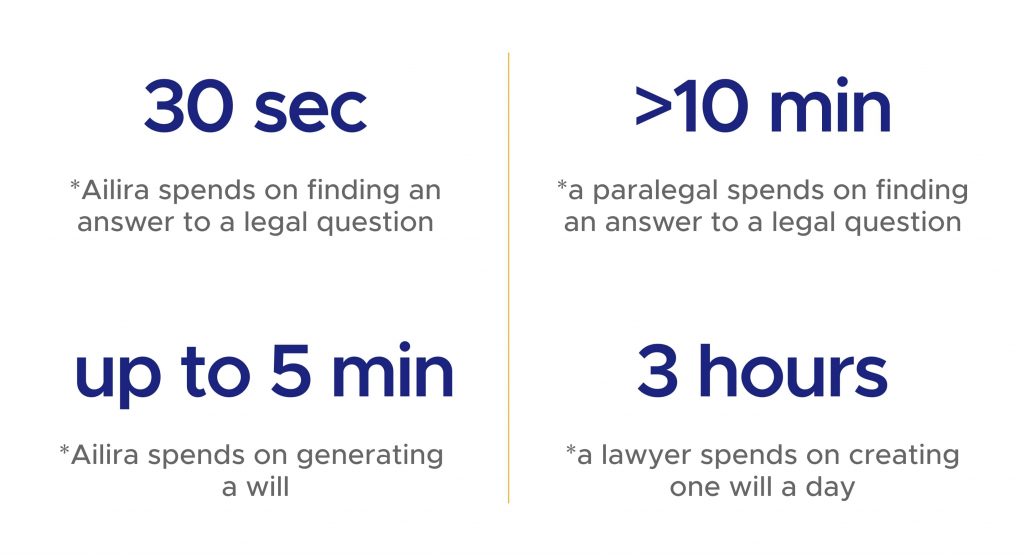
What Is An RPA Chatbot
The global chatbot market has experienced immense growth since 2015. IMARC Group expects the market to grow at an impressive CAGR of 25% through 2026. Two-thirds of the EU companies are already using chatbots — and this number is growing rapidly.
Companies with chatbots have numerous advantages compared to their competitors who ignore AI-powered chatbot potential. What is an RPA chatbot, and how does it differ from a regular AI chatbot?
It's an innovative and intelligent service technology that understands and talks with users in their natural language and excels at back-office processes.
For instance, RPA chatbots take the form of a virtual assistant where the employee inputs a command within a conversational interface, and the chatbot executes the tasks. The specialist can ask the enterprise chatbot to give the customer reports for December. The RPA chatbot pulls the relevant data from the appropriate systems and returns it.

Robotic process automation (RPA)
As is the case with any software, it is crucial to source a solution that provides features that support your business goals. To improve user outcomes while simultaneously easing staff burden, you need to look for a solution that maximizes efficiency, configurability, and accessibility. The following example of chatbot requirements will help to identify a state-of-the-art solution that can be customized to support your needs.
RPA vs Chatbot: What's the Difference?
Since RPA and chatbots share some solid similarities and they are related to automation, people often consider both as the same thing. However, these technologies are not the same.
You might be interested in: ChatGPT for enterprise — discover how to Integrate ChatGPT for Enterprise and save hours of work.
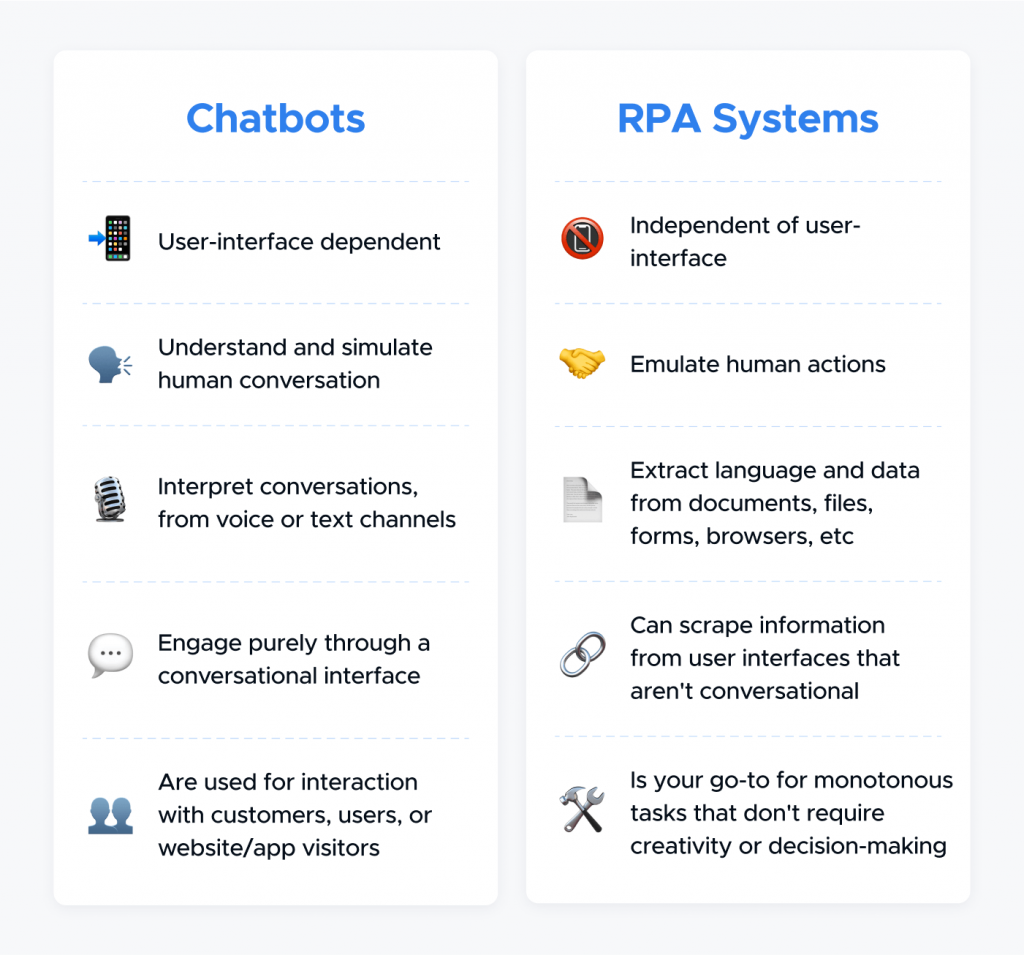
Robotic process automation (RPA)
How Chatbots and RPA Compliment Each Other
Essentially, chatbots and RPA together make for an automation perfect match. Chatbots serve as the front-end interface that interacts with users, while RPA takes care of the heavy lifting in the back-end. Think of these two technologies as the DC or Marvel Super Heroes for your business: individually strong, but unstoppable when teamed up.
An RPA-powered chatbot can integrate with multiple enterprise systems, retrieve information from them, and handle more compound requests. In turn, chatbots can trigger RPA to perform specific repetitive tasks without routing them to a specialist.
We've put together more examples of how they complement each other:
#1. Smarter automation. Some chatbots are developed to be self-learning and contextually aware. They understand user intent, collect the necessary data, and format it for RPA.
#2. Real-time synergy. Imagine a customer asking a chatbot about mortgage approval status. In that case, mortgage lenders have to scan through several documents to check the borrower's ability to repay the loan.
The volumes of data and documents scanned for verification can be quite overwhelming. At the same time, the chatbot can instantly trigger RPA software to pull real-time data from different documents and push it to a structured database, audit documents, and identify the risks associated with the industry.
#3. Boosted user experience. In all honesty, nobody likes filling out long forms or surveys and waiting for responses for an indefinite time. In particular, about 60% of people claim they don't want to take a survey that takes longer than ten minutes. And 87% of people say they don't want to take one that takes longer than 20 minutes.
Chatbots engage users in natural conversation, collecting required information in a way that does not feel like an interrogation. Then, RPA picks everything up to sprint towards the finish line and perform the desired action, such as processing an application for a loan, completing documents, or receiving the necessary papers with a diagnosis after passing tests in the laboratory.
When it comes to scaling your business processes, it is not a matter of choosing between AI-powered chatbots and RPA. It is rather about understanding how to use these two superpowers to increase your business efficiency and customer engagement.
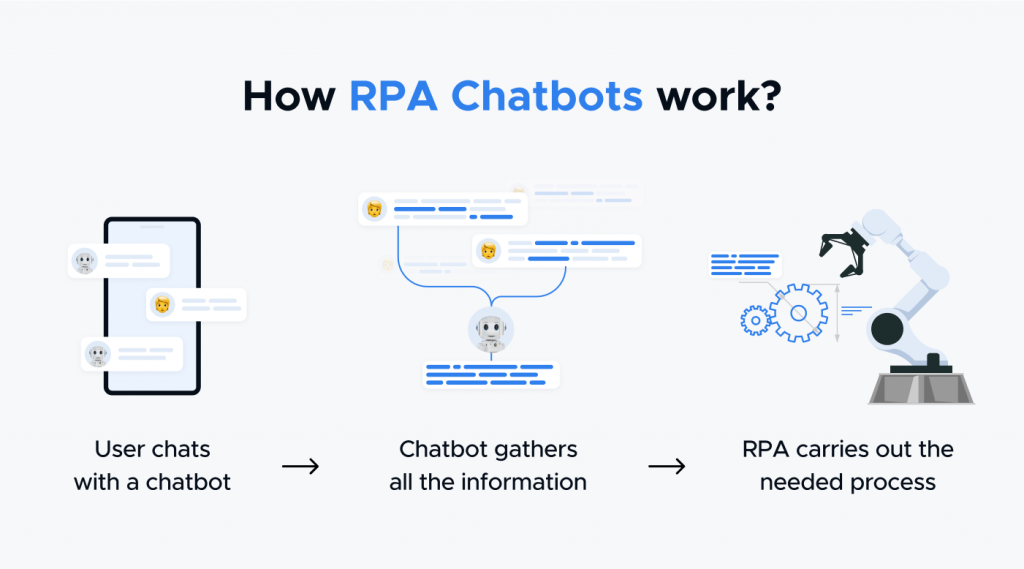
Robotic process automation (RPA)
Imagine automating 60% or more of the routine queries that your full-time specialists handle, leaving them free to resolve the complex ones!
Book a free call, and our experts will personally walk you through the key points of the entire RPA chatbot development process. After releasing 100+ chatbot projects in 7 years, we will help you ensure that you keep each aspect on the development list with no unexpected costs later.
Key Reasons to Combine Chatbots With RPA in Your Business
These two technologies functioning together can create a more frictionless, speedy, and superior experience for both your staff and customers bringing bottom-line benefits to the business.
Reduced Operational Risks
Since RPA lets you efficiently perform complex, error-free tasks, it can help you reduce operational risks to a major extent. Moreover, according to a report by Everest Group, RPA can reduce up to 65% of the operational cost with its potential to register data at the transactional level.
Enhanced Employee and Customer Satisfaction
With RPA, administrative and non-productive tasks like formatting or copy-pasting data are delegated to robots which motivates employees to do more value-added tasks and increases the overall motivational level.

According to Deloitte, 53% of businesses have already introduced RPA in their key operations. This is expected to increase to 72% in the next few years. In addition, lots of enterprises combine Robotic Process Automation with AI chatbots, especially in transaction- or processing-intensive sectors.
For instance, when it comes to banking bots, the process of applying for a mortgage or a credit card account and getting approval is another area where RPA and conversational AI can play a combined role.
Take the example of a mortgage application that a customer has to go through before being approved. The customer journey and approval process are long and complex, requiring multiple steps and handoffs that are fraught with friction and inefficiencies. This can result in losing loan customers during long cycle times.
Even in online apps, it can be difficult to guide customers efficiently through the process, respond to their queries instantly, and bring them through to completion without them dropping the web session.
Wherever there is a customer or employee interaction in a business process that involves repetitive and/or time-intensive processing of transactions and documents, you can think of how RPA and Generative AI could be leveraged to improve the customer experience and employee engagement at a lower operational cost.
To Sum Up
In a nutshell, there are many use cases and benefits of using chatbots with RPA to accelerate business processes. If you haven't tried RPA yet and are not sure about how it works for business, get started by exploring our Chatbot development guide and trying to design an individual solution.
Our company provides services across a range of sectors. Over 62 global enterprises use BotsCrew's services to transform their businesses with automation technologies. We help, mentor, and consult companies from 17+ countries in their intelligent automation journey. BotsCrew rocks in the legal, eCommerce, healthcare, customer service, travel, retail, fintech, and other industries.
Our RPA chatbots can:
- Collect data;
- copy and paste;
- read and write databases;
- move files and folders;
- login into web/enterprise apps;
- open email and attachments;
- collect social media statistics;
- extract structured data from documents;
- make calculations;
- connect to system API, and more.
Frequently Asked Questions (FAQs)
What is RPA in simple words?
Robotic process automation (RPA) is a technology to automate tasks through software robots, or bots. Companies in different industries have leveraged RPA software to complete repetitive tasks and business processes.
What is a chatbot?
Chatbots leverage conversational AI to chat with humans. Chatbot technology is used in various sectors all over the globe. Chatbots are 24/7 available and provide the user with a fast response to resolve common queries.
Do chatbots always use RPA?
No, chatbots and RPA are detached technologies. However, both involve automation (chatbots focus on conversations with users, while RPA automates repetitive tasks) and can be used as a pair to skyrocket your overall business processes.
Are chatbots AI- or RPA-powered?
Modern chatbots are typically considered a form of artificial intelligence. Chatbots use AI technologies such as natural language processing (NLP), machine learning (ML), and generative AI to recognize and respond to user inputs in a human-like manner.
Will RPA replace chatbots?
It is unlikely that robotic process automation will replace chatbots (or vice-versa). Both technologies have very different initiation points and stakeholders. Nevertheless, RPA and chatbots will work together to help include both services together.
Why settle for just trying to keep up when you can lead the future? We provide comprehensive chatbot development and consulting services to help your company leverage AI technologies effectively.
Don't miss out on an opportunity to explore the potential of RPA chatbot developing and integrating AI into your business! Unleash the combined power of Robotic Process Automation and AI-powered chatbots!




